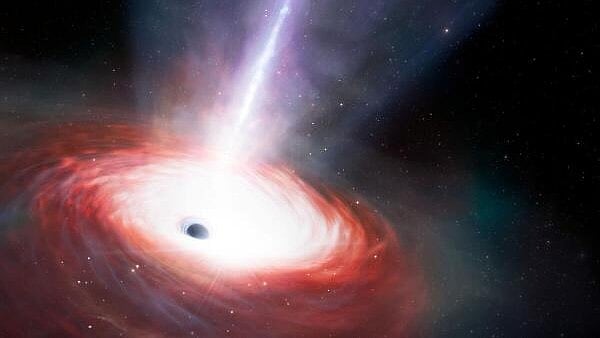
An artist's illustration shows a rapidly feeding black hole.
Credit: NOIRLab/NSF/AURA/J. da Silva/M. Zamani/Handout via REUTERS
Just in time for Halloween, two black holes were in the news.
One is a serial killer, on the verge of devouring its second star in five years. The other is part of what astronomers are calling a black-hole triple, the first known instance of a three-body system that includes a black hole, which is not supposed to be part of the mix, according to standard astrophysics.
Black holes are the bottomless pits of gravity decreed by Albert Einstein's theory of general relativity more than a century ago. Astronomers now know that there are millions of them just in our own galaxy, the Milky Way, the gravestones of stars that imploded and collapsed beyond limit. And every galaxy appears to harbor a supermassive black hole -- which is millions to billions of times as massive as our sun -- at its center.
The killer black hole was first noticed five years ago, when astronomers spotted a flare from the center of a distant galaxy 215 million light-years from Earth. The flare came from a star that had wandered too close to the galaxy's supermassive black hole, a "tidal disruption event" named AT1910qix.
Over the next five months, gravitational forces ripped the star apart and stretched its innards into a ring encircling the black hole. Half of this material fell into the black hole; the other half began drifting away in an expanding disc.
Now, however, that leftover debris has drifted so far out from the black hole that it is interfering with another star.
Every 48 hours, this star crashes through the remnant disc on its way around the black hole, creating a flash of violent X-rays and other radiation. An international team of astronomers led by Matt Nicholl of the Queen's University, Belfast, has been following the action with an array of space telescopes, including the Chandra X-ray Observatory, the Hubble Space Telescope and the Neutron Star Interior Composition Explorer. The team published its results recently in the journal Nature.
"Imagine a diver repeatedly going into a pool and creating a splash every time she enters the water," Nicholl said in a statement released by the Chandra X-ray Center. "The star in this comparison is like the diver and the disc is the pool, and each time the star strikes the surface, it creates a huge 'splash' of gas and X-rays. As the star orbits around the black hole, it does this over and over again."
What is the star's ultimate fate? "It's kind of a race to see what happens first," Nicholls said. "Does it fall into the black hole or smash itself into oblivion?"
In another corner of the sky, astronomers are puzzling over the black-hole triple, officially known as V404 Cygni, which has cast doubt on what astronomers thought they knew about how black holes originate.
The system lies about 8,000 light-years from Earth in the constellation Cygnus. It features one of the oldest known black holes, a beast nine times as massive as the sun that is sucking gas from a nearby star that orbits it every six days -- a typical X-ray binary, at first glance. But a second star also orbits the black hole and its companion, circling them every 70,000 years at such a great distance -- 300 billion miles -- that astronomers almost overlooked it.
How could a black hole maintain its gravitational hold on a star so far away? According to conventional models, a black hole forms when a dying star explodes as a supernova -- which should blow any such distant member of its entourage out of reach, while holding the closer one tightly.
"The way I like to visualize it is, imagine pulling a kite with a spider web," said Kevin Burdge, a research fellow at the Massachusetts Institute of Technology. "If you pull very gently, you might be able to keep the kite flying behind you without the web breaking. But if you do anything to tug on the thread, it would easily snap. Having a supernova is kind of like tugging suddenly on the thread of gravity."
In a paper published in Nature last month, Burdge and his colleagues proposed that there had been no supernova at all. The black hole in V404 Cygni could have resulted from a sort of immaculate conception whereby the progenitor star disappeared from the universe without any fireworks.
Such a thing can happen for stars more than 25 to 40 times as massive as the sun.
"What's interesting here is this one is much lower mass than those," Burdge said. One possibility, he said, was that the black hole's progenitor had expelled much of its original matter before collapsing.
It still sounds unlikely, said Daniel Holz, an astrophysicist at the University of Chicago who was not part of the team. "But in the end, nature decides what can and can't be done."